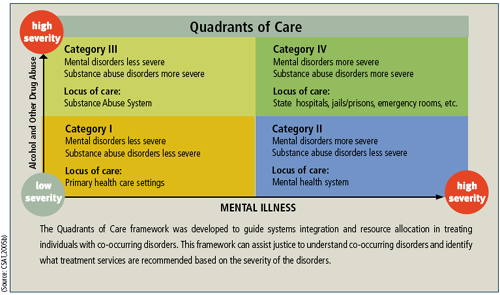
![]()
|
For more information on implementing treatment for individuals with co-occurring disorders: Co-Occurring Disorders: Integrated Dual Disorders Treatment Implementation Resource Kit Institute of Medicine Improving the Quality of Health Care for Mental and Substance use Conditions: Quality Chasm Series |
To understand treatment for co-ocurring disorders, it is helpful to be aware of the different interactions between mental health and substance use disorders. The Quadrants of Care, described on the next page, is a conceptual framework developed by the National Association of State Mental Health Program Directors and National Association of State Alcohol and Drug Abuse Directors to guide systems integration and resource allocation in treating individuals with co-occurring disorders (Reis, 1993). This framework can assist justice and medical professionals to understand the manifestation of co-occurring disorders and identify what treatment services are recommended based on the severity of the disorders.

CATEGORY I.
Less severe mental health disorder and less severe substance disorder
These individuals have low severity substance use and low severity mental disorders. These individuals can be treated in intermediate outpatient settings of either mental health or chemical dependency programs, with consultation between settings. Some individuals may be managed in primary care settings with consultation from mental health and/or substance abuse treatment providers.
CATEGORY II.
More severe mental health disorder and less severe substance disorder
These individuals have high severity mental health disorders usually identified as priority clients within the mental health system and who also have low severity substance use disorders (e.g., in remission or partial remission). These individuals ordinarily receive continuing care in the mental health system and likely to be well served in an intermediate level mental health programs.
CATEGORY III.
Less severe mental health disorder and more severe substance disorder
These individuals have severe substance use disorders and low or moderate severity mental disorders. They are often treated in intermediate level substance treatment programs. There may be a need for coordination with affiliated mental health programs for treatment of the mental disorders.
CATEGORY IV.
More severe mental health disorder and more severe substance disorder
These individuals fall into two subgroups. One group includes those with serious mental illness (SPMI) who also have severe and unstable substance use disorders. The other group includes individuals with severe and unstable substance use disorders and severe and unstable behavioral health problems (e.g., violence, suicidality) who do not meet criteria for SPMI. These individuals require intensive, comprehensive, and integrated services for both their substance use and mental disorders. Treatment can be specialized residential substance abuse treatment programs in state hospitals, jails, or settings that provide acute care such as emergency rooms.









